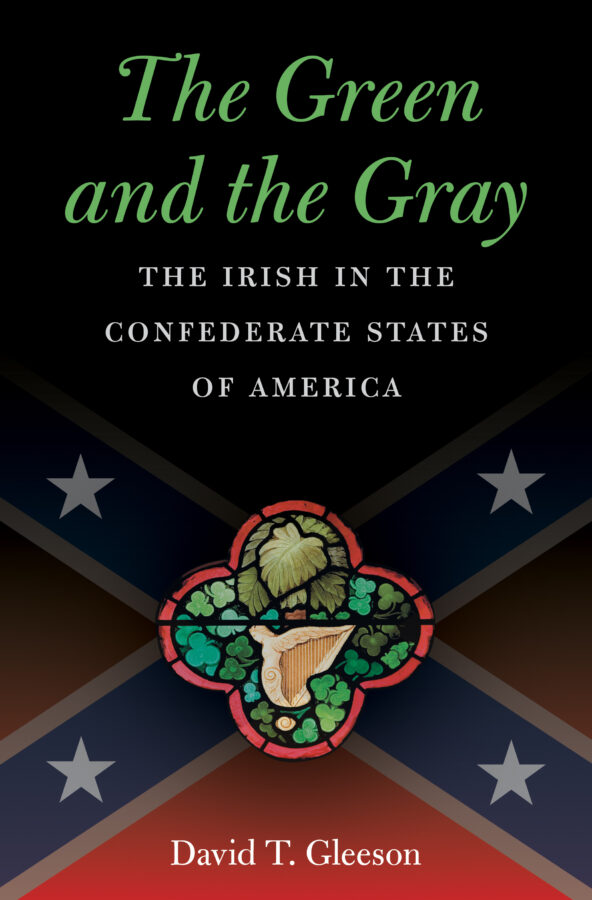The Green and the Gray: The Irish in the Confederate States of America by David T. Gleeson. University of North Carolina Press, 2013. Cloth, ISBN: 1469607565. $35.00.

28books
“The Green and the Gray” by David T. Gleeson.
This interesting new book answers an important question: how did Irish immigrants to the American South during the Civil War era determine their national identity? Dr. Gleeson examines the ideas and experiences of Irish newspaper editors, Catholic Church leaders, soldiers, and civilians to show how complex and compelling the answers to that question were. In doing so, Gleeson contends that the Civil War fundamentally changed the way Irish immigrants thought of themselves and that this story forces us to reorient our understanding of the Civil War from a national struggle to one with global ramifications.
Joining scholars such as Susannah Ural and Kerby Miller, who have examined the social experiences and cultural identities of nineteenth-century Irish immigrants to the United States from a transatlantic perspective, Gleeson has done research on an impressive geographical scale, tracking down archival evidence in every former Confederate state (as well as Maryland, Missouri, and Washington, D.C.) and in the British Foreign Office and Northern Ireland’s Public Record Office. What Gleeson finds is that the tale of how Irish immigrants became Southern, Confederate, and American had many twists in it. As a result, his book helps to open up an important discussion about cultural identity in nineteenth-century America.
Gleeson shows that many Irish newcomers to the South were both supportive of the institution of slavery and “reluctant” to support the region’s secession from the United States. And yet when secession came, Irish immigrants were apt to make comparisons between Ireland’s struggle for independence from Great Britain and the Confederacy’s rebellion against the “tyranny” of the North. While native-born southern politicians might use such comparisons to proclaim that the Confederacy would not suffer Ireland’s fate, Gleeson shows that for Irish newspaper editors such as John Mitchel (who edited the Richmond Enquirer and later wrote for the city’s Examiner during the war), this was not just rhetorical boilerplate. Instead, it served as part of the cultural process by which he adopted a southern identity. Irishmen put their ideological and new regional affinities on the line when they enlisted in the Confederate military, fighting bravely and honorably for the cause. And yet Gleeson notes that Irishmen deserted in large numbers when times got tough in camp, a declension narrative that he argues was replicated on the homefront. The loyalty of many poor Irish immigrants faltered when Union armies came to occupy cities such as New Orleans and offered them work that would alleviate the pinch of economic despair. In the war’s aftermath, however, Irish immigrants in the South, angered both by Radical Republicans’ attacks against Fenian sympathizers in the United States and African Americans’ rise to a level of political equality, adopted the Lost Cause as their own and were re-incorporated into the Confederate fold during commemorative invocations to the sacrifice of all southern soldiers.
It is the sign of a good book, impressive in the scope of its research and ambitious in its argumentation, that it provokes questions. Gleeson’s evidence, which allows him to focus on the writings and activities of several key Irish immigrants such as Mitchel, A. G. Magrath, and Catholic Bishop Patrick Lynch throughout the book, leads him toward the concept of acculturation rather than “whiteness” as the best way to understand Irish Confederates. That is refreshing, for in many ways chronicles of “how the Irish became white” have run into an analytical cul-de-sac. And yet Gleeson’s fine book provokes me to wonder whether he has too narrowly defined identity as self-assertion, rather than as a concept that was negotiated and debated within broader cultures. Studying individuals’ national identity is difficult because they were so apt to adopt and discard national identities when the political winds shifted, as many of Gleeson’s subjects (and other southerners) did at the end of the war. Moreover, while Gleeson recognizes the existence of stereotypical and mythical versions of Irish immigrants percolating through American culture, I think future scholarly work might take up an examination of how Irish men and women were forced to tailor their claims about themselves in light of these stereotypes and in respect to other identity categories such as social class, region, and race. It is ultimately hard to disaggregate Gleeson’s Irish subjects from their native-born southern neighbors at several junctures of the war. For instance, the Irish civilians who lost heart in the Confederate cause during the Civil War appear to be just as “southern” as the native-born white yeomen and soldiers’ wives who, we learn from historians such as Stephanie McCurry and Drew Faust, critiqued the war effort. Certainly, class, regional, racial, and ethnic identities intersected, overlapped, and conflicted with each other in individuals’ experiences and the popular mind. Acknowledging this point would help us clarify just how complicated the acculturation process was and how ambiguous the cultural debate about identity was in Civil War America.
Brian P. Luskey is Associate Professor of History at West Virginia University and the author of On the Make: Clerks and the Quest for Capital in Nineteenth-Century America.

